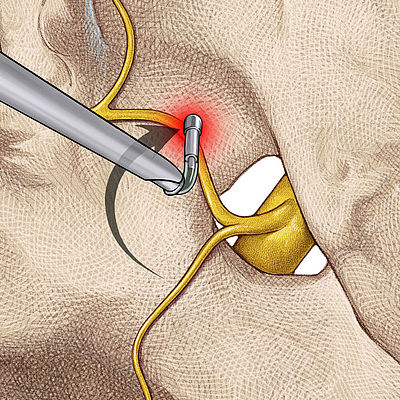
Artist rendering of endoscopic lumbar decompression (courtesy of RIWOspine GmbH).
What is endoscopic sacroiliac EDNA (or rhizotomy) performed used for?
Endoscopic sacroiliac EDNA (or rhizotomy) is a minimally invasive procedure that is used for the treatment of low back and buttocks pain due to an injured or painful sacroiliac joint. The sacroiliac joint is a paired joint, one on either side of the buttocks. The sacroiliac joint joins the pelvis to the part of the spine knows as the sacrum.
How is an endoscopic sacroiliac EDNA (or rhizotomy) performed?
Endoscopic sacroiliac EDNA (or rhizotomy) is performed utilizing an endoscope. An endoscope is a small tube inserted into the body, allowing the surgeon to look inside the body. Because the endoscope is small, only a small band-aid like incision is required. The endoscope has a precision lens on one end and a high definition (HD) camera on the other end. Microscopic instruments are passed through the endoscope to perform surgery. The surgeon visualizes the entire operation using the endoscope mounted HD camera. The surgical video is projected on a high-resolution monitor or heads up display.
To start the procedure, a small incision is made on the skin at the back of the buttocks, over the sacroiliac joint. A small tube 7mm in diameter, (less than half the size of a dime), is then placed through the small incision. The 7mm tube is advanced to the pain sensing nerves along the sacroiliac joint. These nerves are called the “lateral sacral branches.” A small endoscope is placed through the 7mm tube. Specialized micro-instruments are then used to interrupt (cut) the pain sensing nerve, resulting in a back pain cure. Since the major function of the lateral sacral branch is to sense sacroiliac joint pain, there are no untoward side effects. Surgery is guided by real time HD video and x-rays.
What are the advantages of endoscopic sacroiliac EDNA (or rhizotomy)?
Endoscopic sacroiliac EDNA (or rhizotomy) allows the surgeon to cure pain arising from an injured or painful sacroiliac joint. This allows restoration of normal movement, standing, sitting and walking without pain. The tiny openings required for surgery means that there is minimal disruption to the muscles of the buttocks. The sacroiliac joints and ligaments of the pelvis are relatively untouched, allowing normal stability and strength. Performing surgery through a tiny skin incision and leaving healthy tissues intact means a same day procedure with a quicker recovery.
Probably the most significant advantage to endoscopic sacroiliac EDNA (or rhizotomy) is that it provides a long-term cure option for patients with sacroiliac joint pain. Almost every patient undergoing a sacroiliac joint injection will have a return of pain. While patients undergoing radiofrequency rhizotomy have longer relief, they usually relapse as well. Occasionally these patients will have to endure several radiofrequency rhizotomy procedures. endoscopic sacroiliac EDNA (or rhizotomy) provides these difficult patients with a curative procedure.
How long will the procedure take?
The actual endoscopic sacroiliac EDNA (or rhizotomy) surgery typically takes an hour per side treated. You will be in the operating room for an additional hour preparing for surgery and preparing for recovery. After the procedure you will recover for about two hours before going home.
What is the recovery like?
After endoscopic sacroiliac EDNA (or rhizotomy) you will go home the same day with pain medications. In most cases light activity can be resumed the next day. Activity should be tolerably increased over 7 days and should consist of short walks, light exercise and a gradual return to normal daily activities. Avoid strenuous activity and heavy lifting (over 10 to 15 pounds) for the first several weeks. If one’s job is sedentary then work can be resumed in 7 days. Recovery time will vary based on individual factors.

